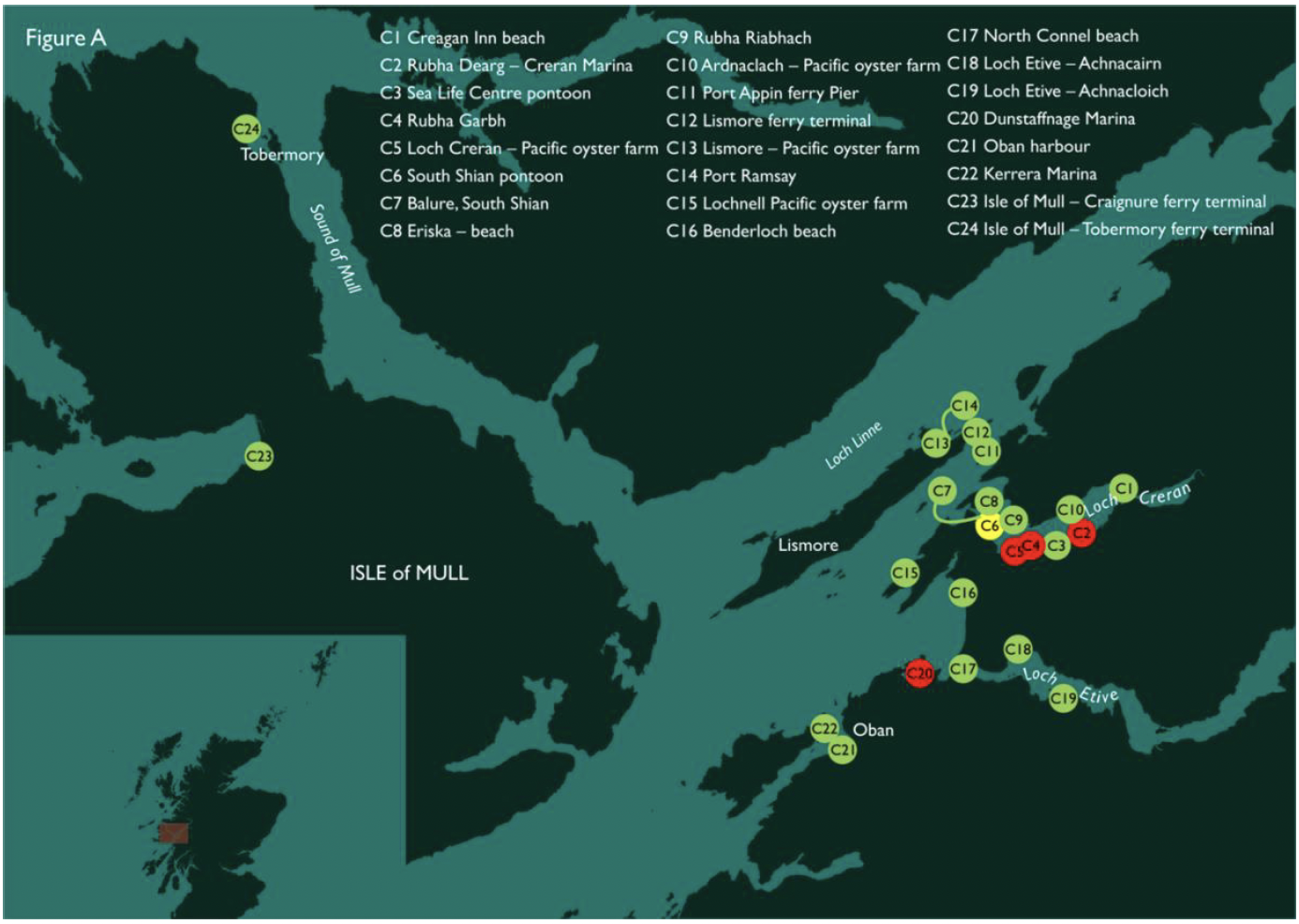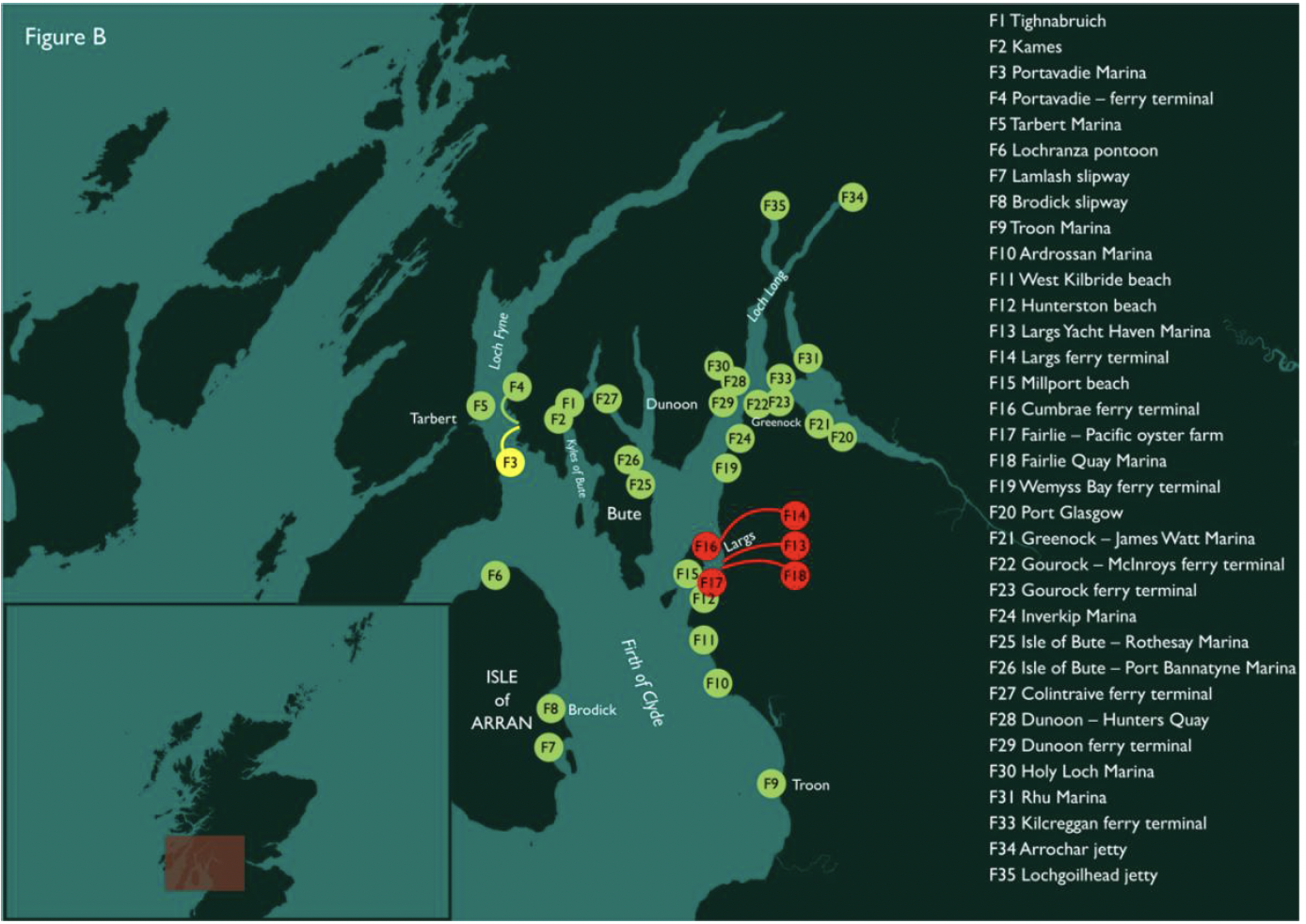Assessing distribution of Didemnum vexillum in Scotland using environmental DNA
This study explores use of environmental DNA (eDNA), DNA shed into water or sediment by organisms inhabiting marine environment, to assess the distribution of Didemnum vexillum in the Firth of Clyde, Loch Creran, and the wider Lynn of Lorn areas.
Results
Within the Loch Creran and wider Lynn of Lorn region, consistent amplification of D. vexillum eDNA was shown for four out of 24 sampling sites (16.7%) (Figure 1A). Three of these sites were situated within Loch Creran and clustered together. Rubha Garbh site (C4) is situated in close proximity to a D. vexillum-impacted Pacific oyster farm (site C5) and the marina in Rubha Dearg (C2) is situated approximately 3.5 km from this farm. In contrast, Dunstaffnage Marina (C20) is situated outside of the Loch Creran, in the wider Lynn of Lorn system, close to the entrance to Loch Etive. Additionally, at site C6, a pontoon in South Shian, Loch Creran, which belonged to a fish processing facility, D. vexillum status was classified as inconclusive, with two out of ten water samples showing an amplification of D. vexillum eDNA in one technical replicate, respectively.
Within the Firth of Clyde system, D. vexillum eDNA was consistently amplified in five out of 34 sites (14.7%) (Figure 1B). All D. vexillum eDNA-positive sites are clustered around Largs (upper Firth of Clyde), including Largs Yacht Haven Marina (site F13), Largs ferry terminal (site F14), the Isle of Cumbrae ferry terminal (site F16), Fairlie Quay Marina (site F18) and the Pacific oyster farm in Fairlie (site F17). At Portavadie Marina (site F3), the status of D. vexillum was reported as inconclusive, with two out of ten water samples showing an amplification of D. vexillum eDNA in one technical replicate, respectively.


No amplification was shown in any negative extraction controls or non-target controls. Two field blank controls, filtered on 6th and 13th August 2019, showed D. vexillum eDNA amplification in one out of three technical replicates (Ct>40). This inconsistent target species detection, most likely caused by a contamination, did not represent a significant issue for this analysis. Sites surveyed at these dates either tested consistently negative for D. vexillum eDNA (sites F1, F2, F11 and F12) or consistently positive (F13 and F14), in every biological sample and technical replicate analysed and it is unlikely that the target species eDNA detection was a result of contamination.
Proportions of water samples with a positive amplification of D. vexillum eDNA varied between sites, ranging from one to all ten water samples (Table 1). The D. vexillum eDNA signal, expressed as the mean copy number of the target eDNA reaction-1, was higher than the assay’s limit of detection (LOD3, Klymus et al., 2020) at all sampling sites where D. vexillum eDNA was detected (Supplementary data S2). Conversely, only five sampling sites (Table 1) reported a D. vexillum eDNA signal higher than the assay’s limit of quantification (LOQ, Klymus et al., 2020) and therefore no detailed quantitative assessment nor comparisons among sampling sites were made in this study.
| Site number | Site name | Number of eDNA positive samples | Target mean copy number reaction -1 (average across positive samples, range) | Number of samples with target mean copy number reaction -1 > LOQ |
|---|---|---|---|---|
| C2 | Rubha Dearg – Marina | 7 | 29.64 (2.68-150.09) | 3 |
| C4 | Rubha Garbh | 1 | 3.13 (1.48-6.11) | 0 |
| C5 | Loch Creran – Pacific oyster farm | 10 | 37.79(1.51-110.36) | 7 |
| C20 | Dunstaffnage Marina | 6 | 5.90 (1.86-13.70) | 0 |
| F13 | Largs Yacht Haven Marina | 10 | 4.6 (1.28-10.27) | 0 |
| F14 | Largs ferry terminal | 10 | 38.91 (12.07-79.10) | 10 |
| F16 | Cumbrae ferry terminal | 3 | 4.83 (2.23-11.59) | 0 |
| F17 | Fairlie – Pacific oyster farm | 10 | 25.61 (8.25-46.00) | 8 |
| F18 | Fairlie Quay Marina | 3 | 14,597.43 (3.10-55,038.60) | 2 |
Sites for which data from both traditional intertidal or subtidal rapid assessments and eDNA detection exist were used to compare outcomes from the two monitoring approaches. There was a high congruence between the visual observation of D. vexillum colonies at the sites during rapid assessments and the detection of D. vexillum eDNA in water samples. For sites in Loch Creran and wider Lynn of Lorn, a congruence in detection of the target species was achieved at 9 out of 13 sites (69.2%), and eDNA data provided robust evidence for presence of D. vexillum at three additional sites and inconclusive evidence at one site. Whereas in the Firth of Clyde area 10 out of 11 sites (90.9%) demonstrated a congruence between different monitoring approaches, with eDNA data providing inconclusive evidence for presence of D. vexillum at one additional site (Table 2).
Contact
Email: Iveta.Matejusova@gov.scot
There is a problem
Thanks for your feedback